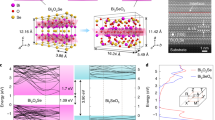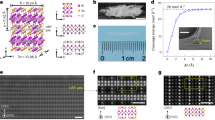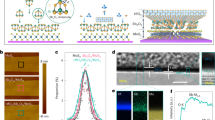Abstract
Scaling down the size of field-effect transistors in integrated circuits leads to higher speed, lower power consumption and increased integration density, but also results in short-channel effects. Transistors made using high-mobility two-dimensional (2D) semiconductor channels and ultrathin high-κ dielectrics can suppress this effect. However, it is difficult to integrate 2D semiconductors with dielectric layers that have an equivalent oxide thickness below 0.5 nm and low leakage current. Here we report the wafer-scale synthesis of β-Bi2SeO5—a single-crystalline native oxide with a dielectric constant of around 22—via the lithography-compatible ultraviolet-assisted intercalative oxidation of the high-mobility 2D semiconductor Bi2O2Se. We use the approach to create top-gated 2D transistors with sub-0.5-nm-equivalent-oxide-thickness dielectrics that exhibit leakage current below the low-power limit of 0.015 A cm−2 at a gate voltage of 1 V.
This is a preview of subscription content, access via your institution
Access options
Access Nature and 54 other Nature Portfolio journals
Get Nature+, our best-value online-access subscription
$29.99 / 30 days
cancel any time
Subscribe to this journal
Receive 12 digital issues and online access to articles
$119.00 per year
only $9.92 per issue
Buy this article
- Purchase on Springer Link
- Instant access to full article PDF
Prices may be subject to local taxes which are calculated during checkout




Similar content being viewed by others
Data availability
The data that support the plots within this paper and other findings of this study are available from the corresponding author upon reasonable request.
References
International Roadmap for Devices and Systems (IEEE, 2021).
Ferain, I., Colinge, C. A. & Colinge, J. P. Multigate transistors as the future of classical metal–oxide–semiconductor field-effect transistors. Nature 479, 310–316 (2011).
Liu, Y. et al. Promises and prospects of two-dimensional transistors. Nature 591, 43–53 (2021).
Yan, R. H., Ourmazd, A. & Lee, K. F. Scaling the Si MOSFET: from bulk to SOI to bulk. IEEE Trans. Electron Devices 39, 1704–1710 (1992).
Akinwande, D. et al. Graphene and two-dimensional materials for silicon technology. Nature 573, 507–518 (2019).
Liu, C. et al. Two-dimensional materials for next-generation computing technologies. Nat. Nanotechnol. 15, 545–557 (2020).
Shen, P.-C. et al. Ultralow contact resistance between semimetal and monolayer semiconductors. Nature 593, 211–217 (2021).
Chang, C. et al. Recent progress on two-dimensional materials. Acta Phys. Chim. Sin. 37, 2108017 (2021).
Illarionov, Y. Y. et al. Ultrathin calcium fluoride insulators for two-dimensional field-effect transistors. Nat. Electron. 2, 230–235 (2019).
Das, S. et al. Transistors based on two-dimensional materials for future integrated circuits. Nat. Electron. 4, 786–799 (2021).
Robertson, J. & Wallace, R. M. High-K materials and metal gates for CMOS applications. Mater. Sci. Eng. R 88, 1–41 (2015).
Illarionov, Y. Y. et al. Insulators for 2D nanoelectronics: the gap to bridge. Nat. Commun. 11, 3385 (2020).
Li, W. et al. Uniform and ultrathin high-κ gate dielectrics for two-dimensional electronic devices. Nat. Electron. 2, 563–571 (2019).
Nichau, A. et al. Reduction of silicon dioxide interfacial layer to 4.6 Å EOT by Al remote scavenging in high-κ/metal gate stacks on Si. Microelectron. Eng. 109, 109–112 (2013).
Britnell, L. et al. Electron tunneling through ultrathin boron nitride crystalline barriers. Nano Lett. 12, 1707–1710 (2012).
Knoblocha, T. et al. The performance limits of hexagonal boron nitride as an insulator for scaled CMOS devices based on two-dimensional materials. Nat. Electron. 4, 98–108 (2021).
Zhu, K. et al. The development of integrated circuits based on two-dimensional materials. Nat. Electron. 4, 775–785 (2021).
Vexler, M. I. et al. A general simulation procedure for the electrical characteristics of metal-insulator-semiconductor tunnel structures. Semiconductors 47, 686–694 (2013).
Li, T. et al. A native oxide high-κ gate dielectric for two-dimensional electronics. Nat. Electron. 3, 473–478 (2020).
Li, T. & Peng, H. 2D Bi2O2Se: an emerging material platform for the next-generation electronic industry. Acc. Mater. Res. 2, 842–853 (2021).
Zhu, H. et al. Remote plasma oxidation and atomic layer etching of MoS2. ACS Appl. Mater. Interfaces 8, 19119–19126 (2016).
Zhang, L. et al. 2D atomic crystal molecular superlattices by soft plasma intercalation. Nat. Commun. 11, 5960 (2020).
Song, S. H. et al. Bandgap widening of phase quilted, 2D MoS2 by oxidative intercalation. Adv. Mater. 27, 3152–3158 (2015).
Yamamoto, M. et al. Self-limiting layer-by-layer oxidation of atomically thin WSe2. Nano Lett. 15, 2067–2073 (2015).
Peimyoo, N. et al. Laser-writable high-k dielectric for van der Waals nanoelectronics. Sci. Adv. 5, eaau0906 (2019).
Lai, S. et al. HfO2/HfS2 hybrid heterostructure fabricated via controllable chemical conversion of two-dimensional HfS2. Nanoscale 10, 18758–18766 (2018).
Chamlagain, B. et al. Thermally oxidized two-dimensional TaS2 as a high-κ gate dielectric for MoS2 field-effect transistors. 2D Mater. 4, 31002 (2017).
Mleczko, M. J. et al. HfSe2 and ZrSe2: two-dimensional semiconductors with native high-k oxides. Sci. Adv. 3, e1700481 (2017).
Tu, T. et al. Uniform high-k amorphous native oxide synthesized by oxygen plasma for top-gated transistors. Nano Lett. 20, 7469–7475 (2020).
Wu, J. et al. High electron mobility and quantum oscillations in non-encapsulated ultrathin semiconducting Bi2O2Se. Nat. Nanotechnol. 12, 530–535 (2017).
Wei, Q. et al. Quasi-two-dimensional Se-terminated bismuth oxychalcogenide (Bi2O2Se). ACS Nano 13, 13439–13444 (2019).
Dityatyev, O. A. et al. Phase equilibria in the Bi2TeO5–Bi2SeO5 system and a high temperature neutron powder diffraction study of Bi2SeO5. Solid State Sci. 6, 915–922 (2004).
Wu, D. et al. Thickness-dependent dielectric constant of few-layer In2Se3 nanoflakes. Nano Lett. 15, 8136–8140 (2015).
Ando, T. et al. CMOS compatible MIM decoupling capacitor with reliable sub-nm EOT high-k stacks for the 7 nm node and beyond. IEDM 16, 236–239 (2016).
Guha, S. et al. High-quality aluminum oxide gate dielectrics by ultra-high-vacuum reactive atomic-beam deposition. J. Appl. Phys. 90, 512 (2001).
Gusev, E. P. et al. Ultrathin high-K metal oxides on silicon: processing, characterization and integration issues. Microelectron. Eng. 59, 341–349 (2001).
Tsai, W. et al. Performance comparison of sub 1 nm sputtered TiN/HfO2 nMOS and pMOSFETs. IEDM 3, 311–314 (2003).
Acknowledgements
We thank X. Wang and J. Pei for the kind help on the capacitance measurement of the metal–insulator–semiconductor heterostructure. We also thank D. Hu for his kind help in the contrast experiment of O3 oxidation with and without UV. We acknowledge Molecular Materials and Nanofabrication Laboratory (MMNL) in the College of Chemistry and Electron Microscopy Laboratory of Peking University for the use of instruments. We also acknowledge financial support from the National Natural Science Foundation of China (21733001, 21920102004, 11974023 and 52021006). H.P. acknowledges support from the Beijing National Laboratory for Molecular Sciences (BNLMS-CXTD-202001) and Tencent Foundation (The XPLORER PRIZE). P.G. acknowledges support from the Key Area R&D Program of Guangdong Province (2018B030327001 and 2018B010109009), and the ‘2011 Program’ from the Peking-Tsinghua-IOP Collaborative Innovation Center of Quantum Matter, Youth Innovation Promotion Association, CAS. J.Y. and K.L. were supported by Welch Foundation grant F-1814.
Author information
Authors and Affiliations
Contributions
Under the direction of H.P., Y.Z. developed the controlled synthesis of single-crystalline β-Bi2SeO5 with the help of T.T. and C.Z. and fabricated the FET devices with sub-0.5-nm-EOT dielectric with the help of M.W., C.T. and Y.W. The MIM measurements for the dielectric constant was carried out by J.Y. under the supervision of K.L. The cross-sectional STEM measurements were performed by R.Z. under the direction of P.G. The top-view TEM, SAED and EDS characterizations were carried out by X.G. and Y.Z. The Bi2O2Se samples were supplied by C.T., M.Y. and Y.Z. The XRD measurements were performed by X.Z. The electron diffraction measurements were finished by X.G. The manuscript was written by H.P. and Y.Z. with input from K.L. and the other authors. The revision of the manuscript is finished by H.L., Y.Z. and H.P. All the work was supervised by H.P. All the authors contributed to the scientific planning and discussions.
Corresponding author
Ethics declarations
Competing interests
The authors declare no competing interests.
Peer review
Peer review information
Nature Electronics thanks Tianyou Zhai and Zhixian Zhou for their contribution to the peer review of this work.
Additional information
Publisher’s note Springer Nature remains neutral with regard to jurisdictional claims in published maps and institutional affiliations.
Supplementary information
Supplementary Information
Supplementary Figs. 1–18.
Rights and permissions
Springer Nature or its licensor holds exclusive rights to this article under a publishing agreement with the author(s) or other rightsholder(s); author self-archiving of the accepted manuscript version of this article is solely governed by the terms of such publishing agreement and applicable law.
About this article
Cite this article
Zhang, Y., Yu, J., Zhu, R. et al. A single-crystalline native dielectric for two-dimensional semiconductors with an equivalent oxide thickness below 0.5 nm. Nat Electron 5, 643–649 (2022). https://doi.org/10.1038/s41928-022-00824-9
Received:
Accepted:
Published:
Issue Date:
DOI: https://doi.org/10.1038/s41928-022-00824-9
This article is cited by
-
Two-dimensional perovskite oxide as a photoactive high-κ gate dielectric
Nature Electronics (2024)
-
Exploring the high dielectric performance of Bi2SeO5: from bulk to bilayer and monolayer
Science China Materials (2024)
-
2D fin field-effect transistors integrated with epitaxial high-k gate oxide
Nature (2023)
-
Prediction of nonlayered oxide monolayers as flexible high-κ dielectrics with negative Poisson’s ratios
Nature Communications (2023)
-
Stamped production of single-crystal hexagonal boron nitride monolayers on various insulating substrates
Nature Communications (2023)



